Hindu and Buddhist Kingdoms
Early Kingdoms
Indonesia like much of Southeast Asia was influenced by Indian culture. From the 2nd century, through the Indian dynasties like the Pallava, Gupta, Pala and Chola in the succeeding centuries up to the 12th century, Indian culture spread across all of Southeast Asia.
References to the Dvipantara or Yawadvipa, a Hindu kingdom in Java and Sumatra appear in Sanskrit writings from 200 BCE. In India’s earliest epic, the Ramayana, Sugriva, the chief of Rama’s army dispatched his men to Yawadvipa, the island of Java, in search of Sita. According to the ancient Tamil text Manimekalai Java had a kingdom with a capital called Nagapuram. The earliest archaeological relic discovered in Indonesia is from the Ujung Kulon National Park, West Java, where an early Hindu statue of Ganesha estimated from the 1st century CE was found on the summit of Mount Raksa in Panaitan island. There is also archaeological evidence of Sunda Kingdom in West Java dating from the 2nd-century, and Jiwa Temple in Batujaya, Karawang, West Java was probably built around this time. South Indian culture was spread to Southeast Asia by the south Indian Pallava dynasty in the 4th and 5th centuries.and by the 5th century, stone inscriptions written in Pallava scripts were found in Java and Borneo.
A number of Hindu and Buddhist states flourished and then declined across Indonesia. Seven rough plinths dating from the beginning of the 4th century CE were found in Kutai, East Kalimantan, near the Mahakam River known as the Yupa inscription or “Mulavarman Inscription” believed to be one of the earliest Sanskrit inscriptions of Indonesia, the plinths were written by Brahmins in the Sanskrit language using the Pallava script of India recalling of a generous king by the name of Mulavarman who donated a huge amount of alms to Brahmin priests in hes kingdom, the kingdom was known as the Kutai Martadipura Kingdom located in present East Kalimantan Province, believed to be the oldest and first Hindu kingdom of Indonesia.
One such early kingdom was Tarumanagara, which flourished between 358 and 669 CE. Located in West Java close to modern-day Jakarta, its 5th-century King, Purnawarman, established the earliest known inscriptions in Java, the Ciaruteun inscription located near Bogor. And other inscriptions called the Pasar Awi inscription and the Muncul inscription. On this monument, King Purnawarman inscribed his name and made an imprint of his footprints, as well as his elephant’s footprints. The accompanying inscription reads, “Here are the footprints of King Purnavarman, the heroic conqueror of the world”. This inscription is written in Pallava script and in Sanskrit and is still clear after 1500 years. Purnawarman apparently built a canal that changed the course of the Cakung River, and drained a coastal area for agriculture and settlement purpose. In his stone inscriptions, Purnawarman associated himself with Vishnu, and Brahmins ritually secured the hydraulic project.
Around the same period, in the 6th to 7th centuries, the Kalingga Kingdom was established in Central Java northern coast, mentioned in Chinese account. The name of this kingdom was derived from ancient Indian kingdom of Kalinga, which suggest the ancient link between India and Indonesia.
The political history of Indonesian archipelago during the 7th to 11th centuries was dominated by Srivijaya based in Sumatra and Sailendra that dominated southeast Asia based in Java and constructed Borobudur, the largest Buddhist monument in the world. The history prior of the 14th and 15th centuries is not well known due to the scarcity of evidence. By the 15th century, two major states dominated this period; Majapahit in East Java, the greatest of the pre-Islamic Indonesian states, and Malacca on the west coast of the Malay Peninsula, arguably one of the greatest of the Muslim trading empires, this marked the rise of Muslim states in the Indonesian archipelago.
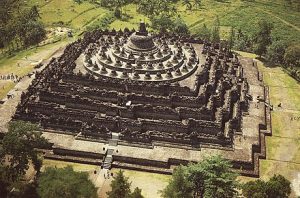
8th century Borobudur Buddhist monument, Sailendra dynasty, it is the largest Buddhist temple in the world.
Medang Empire - Mataram
Medang Empire, sometimes referred to as Mataram, was an Indianized kingdom based in Central Java around modern-day Yogyakarta between the 8th and 10th centuries. The kingdom was ruled by the Sailendra dynasty, and later by the Sanjaya dynasty. The centre of the kingdom was moved from central Java to East Java by Mpu Sindok. An eruption of the volcano Mount Merapi in 929, and political pressure from Sailendrans based in the Srivijaya Empire may have caused the move.
The first king of Mataram, Sri Sanjaya, left inscriptions in stone. The monumental Hindu temple of Prambanan in the vicinity of Yogyakarta was built by Pikatan. Dharmawangsa ordered the translation of the Mahabharata into Old Javanese in 996.
In the period 750 CE – 850 CE, the kingdom saw the blossoming of classical Javanese art and architecture. A rapid increase in temple construction occurred across the landscape of its heartland in Mataram (Kedu and Kewu Plain). The most notable temples constructed in Medang Mataram are Kalasan, Sewu, Borobudur and Prambanan. The Empire had become the dominant power (mandala) not only in Java but also Srivijayan Empire, Bali, southern Thailand, Indianized kingdoms of Philippines, and Khmer in Cambodia.
Later in its history, the dynasty divided into two dynasties based on their own religion, the Buddhist and Shivaist dynasties. Civil war was unavoidable and the outcome was Medang Empire divided into two powerful kingdom based on region and religion. The Shivaist dynasty of Medang kingdom in Java led by Rakai Pikatan and the Buddhist dynasty of Srivijaya kingdom in Sumatra led by Balaputradewa. The hostility between them didn’t end until in 1006 when the Sailendran based in Srivijaya kingdom incited rebellion by Wurawari, vassal of Medang kingdom and sacked Shivaist dynasty’s capital in Watugaluh, Java. Srivijaya kingdom rose into undisputed hegemonic Empire in the era as the result. Yet the Shivaist dynasty survived and successfully reclaimed the east Java in 1019 then descended to Kahuripan kingdom led by Airlangga son of Udayana of Bali.
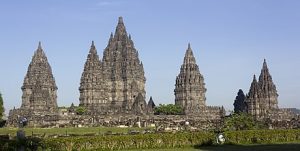
Prambanan in Java was built during the Sanjaya dynasty of Mataram Kingdom, it is one of the largest Hindu temple complexes in Southeast Asia.

Sewu temple in Special Region of Yogyakarta.
Srivijaya
Srivijaya was a kingdom on Sumatra which influenced much of the Maritime Southeast Asia. From the 7th century, the powerful Srivijaya naval kingdom flourished as a result of trade and the influences of Hinduism and Buddhism that were imported with it.
Srivijaya was centred in the coastal trading centre of present-day Palembang. Srivijaya was not a “state” in the modern sense with defined boundaries and a centralised government to which the citizens own allegiance. Rather Srivijaya was a confederacy form of society centred on a royal heartland. It was a thalassocracy and did not extend its influence far beyond the coastal areas of the islands of Southeast Asia. Trade was the driving force of Srivijaya just as it is for most societies throughout history. The Srivijayan navy controlled the trade that made its way through the Strait of Malacca.
By the 7th century, the harbours of various vassal states of Srivijaya lined both coasts of the Straits of Melaka. Around this time, Srivijaya had established suzerainty over large areas of Sumatra, western Java, and much of the Malay Peninsula. Dominating the Malacca and Sunda straits, the empire controlled both the Spice Route traffic and local trade. It remained a formidable sea power until the 13th century. This spread the ethnic Malay culture throughout Sumatra, the Malay Peninsula, and western Borneo.[citation needed] A stronghold of Mahayana Buddhism, Srivijaya attracted pilgrims and scholars from other parts of Asia.
The relation between Srivijaya and the Chola Empire of south India was friendly during the reign of Raja Raja Chola I but during the reign of Rajendra Chola I the Chola Empire attacked Srivijaya cities. A series of Chola raids in the 11th century weakened the Srivijayan hegemony and enabled the formation of regional kingdoms based, like Kediri, on intensive agriculture rather than coastal and long distance trade. Srivijayan influence waned by the 11th century. The island was in frequent conflict with the Javanese kingdoms, first Singhasari and then Majapahit. Islam eventually made its way to the Aceh region of Sumatra, spreading its influence through contacts with Arabs and Indian traders. By the late 13th century, the kingdom of Pasai in northern Sumatra converted to Islam. The last inscription dates to 1374, where a crown prince, Ananggavarman, is mentioned. Srivijaya ceased to exist by 1414, when Parameswara, the kingdom’s last prince, fled to Temasik, then to Malacca. Later his son converted to Islam and founded the Sultanate of Malacca on the Malay peninsula.
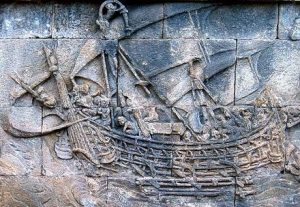
As early as the 1st century CE Indonesian vessels made trade voyages as far as Africa. Picture: a ship carved on Borobudur, c. 800 CE.
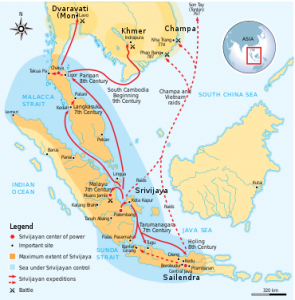
the territory of the Srivijaya empire. Historically, Srivijaya was one of the largest kingdoms in Southeast Asia.
]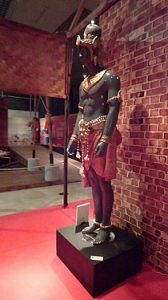
Singhasari and Majapahit
Despite a lack of historical evidence, it is known that Majapahit was the most dominant of Indonesia’s pre-Islamic states. The Hindu Majapahit kingdom was founded in eastern Java in the late 13th century, and under Gajah Mada it experienced what is often referred to as a “Golden Age” in Indonesian history, when its influence extended to much of southern Malay Peninsula, Borneo, Sumatra, and Bali from about 1293 to around 1500.
The founder of the Majapahit Empire, Kertarajasa, was the son-in-law of the ruler of the Singhasari kingdom, also based in Java. After Singhasari drove Srivijaya out of Java in 1290, the rising power of Singhasari came to the attention of Kublai Khan in China and he sent emissaries demanding tribute. Kertanagara, ruler of the Singhasari kingdom, refused to pay tribute and the Khan sent a punitive expedition which arrived off the coast of Java in 1293. By that time, a rebel from Kediri, Jayakatwang, had killed Kertanagara. The Majapahit founder allied himself with the Mongols against Jayakatwang and, once the Singhasari kingdom was destroyed, turned and forced his Mongol allies to withdraw in confusion.
Gajah Mada, an ambitious Majapahit prime minister and regent from 1331 to 1364, extended the empire’s rule to the surrounding islands. A few years after Gajah Mada’s death, the Majapahit navy captured Palembang, putting an end to the Srivijayan kingdom. Although the Majapahit rulers extended their power over other islands and destroyed neighbouring kingdoms, their focus seems to have been on controlling and gaining a larger share of the commercial trade that passed through the archipelago. About the time Majapahit was founded, Muslim traders and proselytisers began entering the area. After its peak in the 14th century, Majapahit power began to decline and was unable to control the rising power of the Sultanate of Malacca. Dates for the end of the Majapahit Empire range from 1478 to 1520. A large number of courtiers, artisans, priests, and members of the royal family moved east to the island of Bali at the end of Majapahit power.
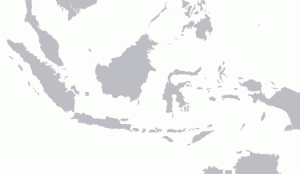
Expansion of the Majapahit empire extended to much of the Indonesian archipelago until it receded and fell in the early 16th century.
]
Gajah Mada, a powerful military leader, credited with bringing the empire to its peak of glory.
